Human Flower Project
Monday, April 14, 2008
Mullickghat Rises from Its Ashes
Sandy Ao takes us to Kolkata’s huge flower market, destroyed by fire Friday night, back in business by Saturday.
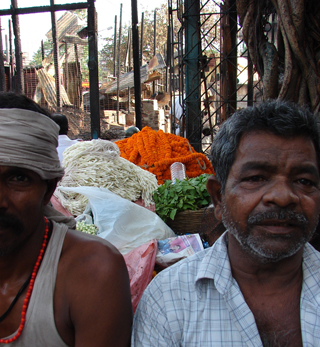
The shops of more than two hundred flower sellers
burned Friday night in Kolkata, India
Photo: Sandy Ao
Fire broke out Friday night, April 11, at the immense Mullickghat flower market in Kolkata, India. Eighteen fire engines were called to the scene along the Hoogly River, as blazes swept down Strand Road, charring more than 200 – nearly all – of the market’s flowers stalls.
The fire destroyed the 125-year Mullickghat just before the Bengali New Year, a huge floral occasion. For decades the largest flower market in all Asia (though now surpassed by the sales center in Delhi ), Mullickghat both served local customers in this city of 13 million people and exported the region’s tuberoses, marigolds, gladioli and scores more varieties to Europe, the Middle East and Asia.
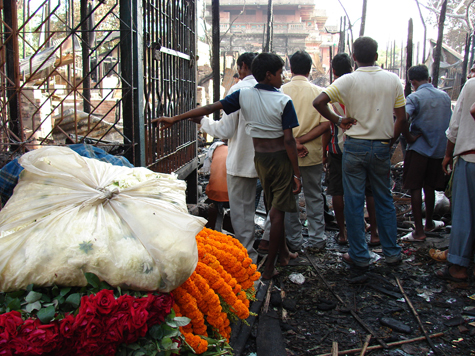
Boys survey the remains of the market on April 12
Photo: Sandy Ao
Merinews reported Saturday, “About 2,000 flower growers from the districts visited the market daily to sell their produce”—a number that doubled around major festivals and during India’s wedding season, which is now beginning. “The livelihood of 25,000 people has been affected.”
The Thai Indian interviewed Ramesh Kundu, a flower seller whose place of business was wiped out. “Each one of us has suffered a loss of minimum Rs.80,000 (roughly $2000 USD). With Bengali New Year on April 14 we had stocked four times more flowers than usual. Now this fire has turned us into beggars.”
Sandy Ao, who alerted us to the tragedy, has posted an amazing album of her photographs and a moving account of many experiences in the market on her weblog. She also generously shared many photographs and thoughts with us.
“The fire was around the Lady’s bathing ghat,” Sandy writes. “One cannot stop imagining that it is a case of arson; that’s what I heard people in the market hissing about.” Newspaper accounts confirm that many in Kolkata suspect the fire was set intentionally. The Statesman reports charges that the ruling party may have arranged to have Mullickghat destroyed to make way for an immense, modern (and expensive) structure that’s been on the drawing board for years.
Sudhangshu Sil, the local member of Parliament, was quick to announce: “The greatest consolation is (that) in February the Calcutta Municipal Corporation sanctioned the plan for a three-storey building with basement here, which will rehabilitate the 5,000 flower traders and be India’s first flower auction centre.”
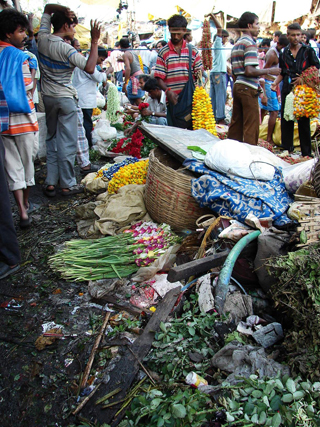 Flower vendors make do after Friday’s fire in Kolkata
Flower vendors make do after Friday’s fire in Kolkata
Photo: Sandy Ao
Sandy Ao says that arson fires tend to be Kolkata’s prelude to “improvement” projects; considering the horrors undertaken in the U.S., the razing of whole downtown neighborhoods, in the name of “urban renewal,” why should we be surprised?
Planners of the new flower complex say that it will include cold storage, facilities for sorting, grading and packaging flowers, laboratories for extracting flower oil, and lodgings. As proposed, the air-conditioned complex would be a far cry from the century-old street market. Centered around the Lady Ghat near the river’s Howrah Bridge, Mullickghat has been a traditional open-air venue. Before the fire there were more than two hundred small structures for vendors, but according to Sandy, many hundreds more flower sellers strung garlands and sold their calotropis and roses from bags and baskets below the bridge, along Strand Road and all around the edges.
“The official report was that Mullickghat had been completely gutted,” Sandy writes. “Actually there are 265 odd shops/stalls as recorded in the Mullickghat Society book, each paying Rs.130/-per month as rent to be recorded as legal flower dealers here, whereas the other groups of flower dealers who do not own any stalls/shops pay Rs.7/- each per day to the society. And these groups are the backbone of Mullickghat. I should say 95% of the thousand flower sellers are made up of these groups.”
Is affection for the old open-air market and grief at the idea its replacement by modern facilities all stupid romanticism? It’s easy to relish the excitement of this place at a remove, through Sandy’s images, but what about withstanding the rainy season here, or enduring summer days, as roses wilt through the afternoon? Maybe the new flower complex would be better for everyone.
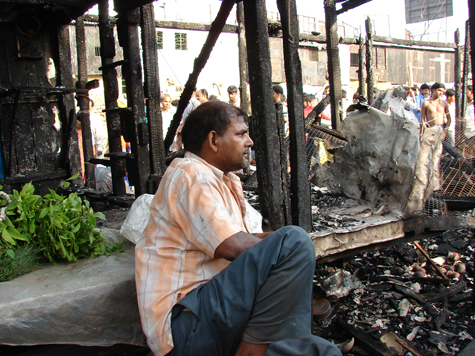
One of the Mullickghat flower shop owners who lost his business in the fire
Photo: Sandy Ao
“I got some feedback from some of the young Kolkatans,” Sandy writes, “They too express their skepticism about this new modern flower market in Mullickghat. You know, we have had so many such plans and projects. All took off the ground with grandeur, but all resulted in flop projects. In our point of view, this has become a golden opportunity for the greedy officials/politicians to dig their fingers into this goldmine.” She asks,
“Who will rent the shops in this new facility? Who will need such facility?
Who will manage it?”
Even if public funds really are all diverted to the new building, Sandy offers some reasons why it isn’t needed – or even wanted – here.
“Most of the flowers they deal in at this market are related to some religious purposes. (Remember, each of the gods/goddesses has no less than 108 names! In fact, with only 365 days a year, it’s hard to hold all the pujas and the rituals!) The flowers required for all these gods/goddesses are local products. Who will need cold storage for marigolds, tuberoses, tulsi, hibiscus, bael leaves, roses, sunflowers, cockscomb, daisies, jasmine, magnolia, lotus… all of which are hardy?” she asks. “Besides, most of these flowers get sold off within 24 hours!”
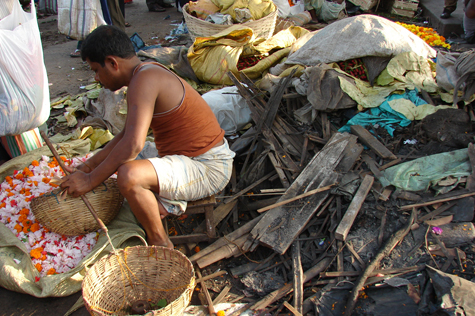
Doling out marigold and jasmine flowers after the fire
Photo: Sandy Ao
Exports from Mullickghat have been suspended for the next week, but there does appear to be a heavy trade in exported flowers, in addition to the strong local market Sandy describes. Perhaps it’s this more international end of the Kolkata flower trade that the new building is designed to serve.
Sandy raises questions about the operation of such a facility, if plans move ahead. “How will it be managed? as we are incapable of managing anything where strict discipline is required! We must remember, the Bengalis believe they are the image of Lord Shiva, who is the creator and the destroyer… But never the preserver!!! We have had many projects which ended being some monsters/eye-sores of Kolkata.”
If it is ultimately built, will the new market be a success? Our friend doubts it.
“At this moment we are having daily power-cuts —that, too, in 38.8C weather conditions. The real summer is yet to come. Where will the electricity come from to facilitate the cold storage? Nuclear energy? Not a chance, for our Left Party is not going to accept the Central Government’s signing the Nuclear Treaty. I can already see how this modern flower market is going to take shape in this summer heat: Then we’ll see the magic of Mullickghat’s flower power!”
The morning after the fire, Sandy took her camera to the market she’s photographed many times before. “A few of the stall owners simply sat there speechless. One of them, the supplier, told me his loss is unaccountable. Above all they lost the good season to do business within these two days; for Monday is the Bengali New Year. I too became speechless. I smelled burnt wood in the midst of the roses. I guess this smell will stay with me for a long time.
“Nothing seemed to be right, for the weather was very humid, dull and hot. But I was having hope in my heart that Mullickghat is not completely destroyed. And when I saw the crowd near the footbridge, my spirit lifted up!” Sandy said there were even more shoppers than on an ordinary Saturday. ”I told myself ‘Good! Mullickghat is still standing strong. I guess we Indian are the survivors.’”
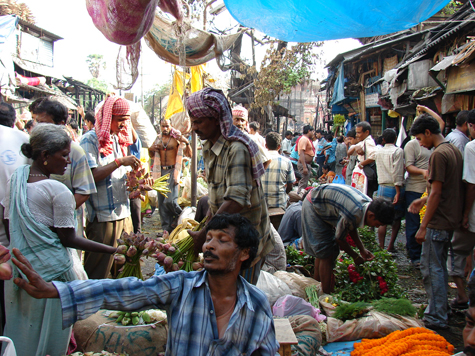
Back in the business of lotus buds and marigolds, April 12, 2008
Photo: Sandy Ao
The Kolkata newspaper also reported that by Saturday, scores of the vendors were doing buisiness, their fresh marigolds and tuberoses arrayed on the ashes.
“People of this country have seen how many civilizations come and go,” Sandy writes. “Everything has its present, future and its past. In due course, Mullickghat will have a modern building for selling flowers, but the people will still put up their usual stalls around the building and sell their fresh marigolds, roses, calotropis, tuberoses, magnolia, bael leaves…like what they have been doing for the last 125 years. Those who want to rent a shop in the modern market can go ahead and rent a shop there. The other 95% of flower sellers will carry on doing their flower business in the normal way that they are doing now. It may not be exactly same like before, but it will not vanish either. If the government tries to stop them, they will use the mass-power to fight for their right. After all, in Kolkata we are very much aware of the effects of the mass-power! Otherwise Kolkata would not be known as the city of bandhs/strikes!!”
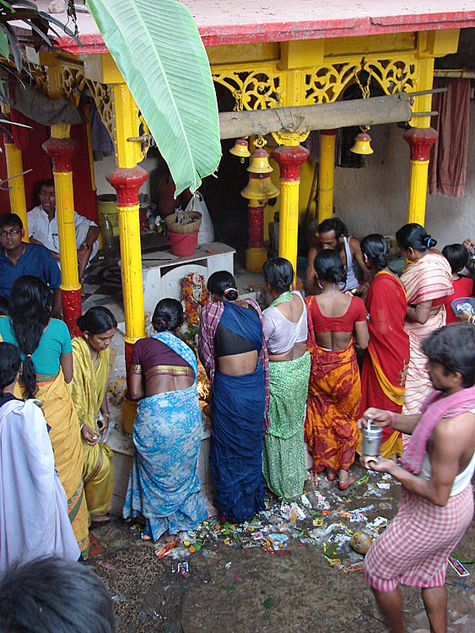
Religious observances go on Saturday, April 12, in Kolkata
with floral offerings to Shiva at the temple by the Mullickghat market
Photo: Sandy Ao
The city’s forensic experts have concluded that Mullickghat’s fire began when a fuel canister ignited at the Lady Ghat. Local officials say that the flower sellers – those with shops, anyway—will be compensated for their losses, and promise that the modern Mullickghat building, long delayed, will proceed.
But Sandy writes about the present: ”I see devotees still crowding the nearby temple offering the flowers to the gods with the same faith in their faces….And today I saw how they made beautiful calotropis garlands for Shiva to welcome the New Year.”
Culture & Society • Cut-Flower Trade • Florists • Politics • Religious Rituals • Permalink




